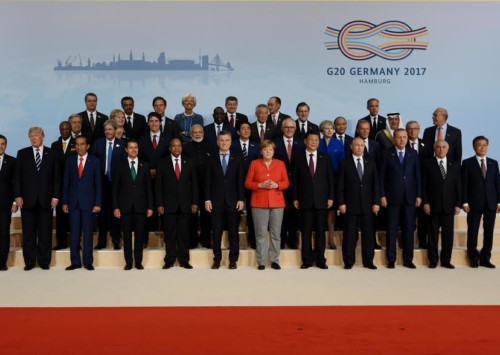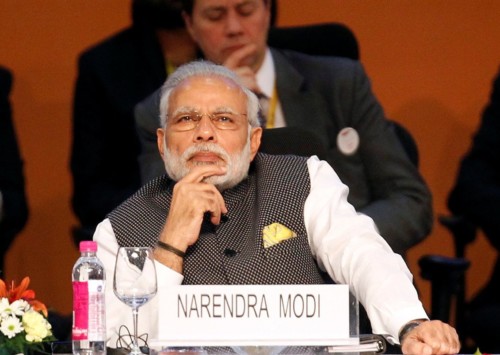Modi, Xi Jinping meet in Mamallapuram

Indian Prime Minister Narendra Modi and Chinese President Xi Jinping in the coastal town of Mamallapuram, for the second ‘informal summit’
India and China are actively trying to renew their relationship and therefore the informal summits. However, it remains to be seen whether there will be any tangible outcome from the “informal summits.”
The second informal summit between Prime Minister Narendra Modi and Chinese President Xi Jinping was held in the coastal town of Mamallapuram, 50 kilometres south of Chennai; almost 18 months after the first informal summit took place in Wuhan, China. The two-day summit (October 11-12) that concluded on Saturday saw the leaders of both the countries touching upon issues pertaining to trade, defence, people to people contact and terrorism and radicalisation.
Among the key decisions taken at the summit was the setting up of a high-level trade mechanism between the two nations to discuss trade, investment and services, Indian foreign secretary Vijay Gokhale informed the media. A new focus was given on promoting people to people relations. In order to bring together people of both countries together, it was decided that 70 events would be held in the two countries – 35 on each side, to broaden people-to-people contact. Modi felt greater emphasis should be laid on tourism. India also raised the issue of joining the China-led free trade bloc, the Regional Comprehensive Economic Partnership trade talks, said Gokhale.
The formal outcome from the informal summit
Even though the ‘informal summit’ is considered to be an important way through which both the countries are going to discuss issues as per their national priority but what can be seen from both the summits is just the two governments issuing statements without having to worry about the ‘deliverables’. Last year at the end of Wuhan summit, foreign secretary Vijay Gokhale had said that the main takeaway from the summit was that the two leaders had agreed to improve “strategic communication.” However, if one sees at the communications between both the countries in the past few months it has been anything but strategic. China has time and again been critical about India’s actions be it in on the issues of Kashmir or the Indian military exercise in Arunachal Pradesh. The relations also soured after both the countries engaged in the 73-day long standoff at Doklam, the site of a trilateral border that the two giants share with the small Himalayan kingdom of Bhutan, two years ago.
After the Wuhan summit India and China had decided to jointly implement projects in other countries. It was nicknamed as the ‘2+1’ and joint projects were expected to be implemented in Afghanistan. However, in the last 18 months, there has been little, if any, progress. Meanwhile, the border tensions continue to flare up from time to time and the hard Chinese stance on the abrogation of autonomy for Kashmir has been a cause of concern in India, which has repeatedly reiterated that Kashmir is an internal matter of India and no other country has anything to do with it.
In 2017, the bilateral ties between both the countries turned bitter over the USD 60 billion China-Pakistan Economic Corridor (CPEC), which is part of the Belt and Road Initiative (BRI). India has criticised the CPEC as it passes through the part of Jammu & Kashmir under Pakistani occupation, while India says the entire landmass of J&K is an integral part of India and the Pakistan occupation was illegal. In addition, India has also been watching warily China dolling out billions of dollars in loans for infra projects to smaller countries in India’s immediate neighbourhood in South Asia. India is worried that its relations with countries like Maldives, Sri Lanka and Nepal would be harmed if these nations were caught in a debt-trap by the Chinese through their massive infrastructure projects.
Sri Lanka is heading for elections and a member of the China-friendly Rajapaksa family is said to “restore relations” with its biggest lender. Similarly, even though India has been quite supportive of Maldives after its formation of a new government last year, the island nation remains heavily indebted to China and is in no position to ignore the emerging superpower. So is the case with Nepal and Bangladesh who have also grown close to the Chinese in the last few years. Jinping will visit Nepal on October 13, and is likely to sign agreements, including a feasibility study for bringing railways to the Himalayan nation and event connect it with the Chinese railway system as part of the BRI.
China has also stridently opposed India’s efforts to join the Nuclear Suppliers Group, which could boost India’s nuclear power projects. China has also been blocking Indian moves at the United Nations to declare Pakistan-based terror outfit Jaish-e-Muhammad chief Masood Azhar as a global terrorist.
These issues predate Wuhan meet, which had been organised to reset the ties and ease down the emerging tensions between both the nations. But it remains to be seen whether just like the last summit at Wuhan, if this summit will lead to any real progress.
Some experts believe, though, that the informal summits can be a useful exercise. Seeing the bonhomie at the Mamallapuram meet, Jinping suggested that informal summits with free-wheeling discussions is the way to go for India and China and “future leaders should follow it”. The Chinese leader has already invited Modi for the third informal meet in China.
Indo-China relations
Even though the relations between the two countries have not been cordial enough but still both the countries have engaged in informal summits and joined platforms such as the Russia-India-China (RIC), Brazil-Russia-India-China-South Africa (BRICS), and the Shanghai Cooperation Organisation (SCO). China’s vice foreign minister and former ambassador to India, Luo Zhaohui, said this week that “relations have entered a new stage of steady growth, with the cooperation and exchanges being carried out in various fields and differences being properly managed.”
India and China together account for nearly 35 global population and 17.6 pc of the global economy, with India being China’s largest trading partner in South Asia. Their estimated USD 84 billion bilateral trade in 2017-18 was a mere fraction of the US-China trade volume that stood at almost USD 600 billion. Foreign direct investment into India has risen from less than USD 25 billion in 2014 to about USD 45 billion in the last fiscal year. Indian companies are expanding in the Chinese market with a cumulative investment of nearly USD 1 billion.
According to the latest official Chinese data, the trade deficit in 2018 climbed to USD 57.86 billion from USD 51.72 billion in 2017. Further, in the first five years of the financial year, bilateral trade declined by 3.59 pc year on year, which means that it may not cross USD 100 billion in 2019. Chinese ambassador to India, Sun Weidong said that Chinese investment in India stood at USD 8 billion, with over 1,000 Chinese firms investing in industrial parks, e-commerce and other areas, and creating 200,000 local jobs.
FIEO president Sharad Kumar Saraf, in a statement, said that India’s trade deficit with China was a ’cause of concern’. “A bigger worry is the market access which is restricting Indian exports to realise its true potential,” he said, adding the country’s untapped export potential was pegged as USD 18 billion much more than country’s exports of USD 16.8 billion. Dairy products, bovine meat, soybean meal and many fruits are not given market access which is equally a problem for Indian pharmaceuticals industry as registration takes an enormous amount of time, he said. According to him, India being a large market and having corporate tax rate at 15 pc much less than 25 pc in China is best positioned to attract investments.
A major segment that has seen growth in the Indian market is the Chinese smartphone industry. The Chinese company Xiaomi has tripled the number of smartphone plants it has in India in recent years and is now on its way to taking top spot in the country’s market. The country is also hoping that India could be a big market for telecoms giant Huawei, which is facing increasing pressure and restrictions from the US.
Ahead of the ‘informal summit’ in Chennai, 129 Memorandum of understanding (MoUs) were signed between the Indian and Chinese companies. The MoUs were signed for sectors like – agri-related products, minerals, textiles, food-processing, yarns, minerals etc.
Silence over Kashmir
A few days prior to the summit Chinese ambassador to Pakistan, Yao Jing was quite supportive of Pakistan’s stand on the Kashmir dispute and said “We are also working for Kashmiris to help them get their fundamental rights and justice. There should be a justified solution to the issue of Kashmir and China will stand by Pakistan for regional peace and stability.” India, understandably, protested the statement and sought clarification on China’s changing position on Jammu and Kashmir.
However, the scenario was completely different during the summit. There was an unspoken understanding between the leaders of the two nations on how not to discuss the key political problems of both nations. India wanted its Chinese counterparts not to comment on anything related to Kashmir as it considers it to be an ‘internal issue’. This silence by China comes in the backdrop of it taking India to the UN Security Council on behalf of Pakistan, which sought a meeting on the Jammu and Kashmir issue following India’s decision to remove the special status to the state of Jammu and Kashmir through Article 370.
With much being made of the ‘outcomes’ of the Mamallapuram meet, it now the responsibility of the two leaders to ensure that they keep the conversation on, even through telephones, to prevent any flare ups in the bilateral ties and to motivate their teams to work to resolve or make visible progress on the numerous issues that divide the Asian giants. If this is the case, then they can duly congratulate themselves at the next informal meeting and keep going the format for the future.













